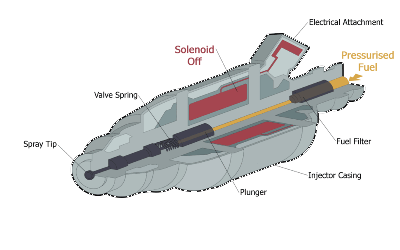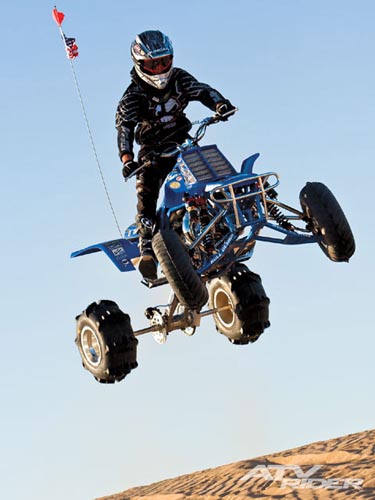Fuel-injection is not a new idea, the first mechanical system was invented in 1925 by Swedish engineer Jonas Hesselman. The concept was adapted for use in gasoline-powered aircraft during World War II. Then in 1940 Alfa-Romeo tested the first Electronic fuel-injection systems.
Fuel Injection systems virtually replaced carburetors in the automotive field by the late 1980’s. The way fuel-injection differs from a carburetor is that fuel is atomized due to being forced through a small nozzle using high pressure in fuel-injection. While the carburetor relies on low pressure created by intake air, drawing the fuel into the air-stream.
Over the past few years, fuel-injection has been the talk of many two-stroke racers and fans. As they see fuel-injected two-strokes as the saviors of the species, since four-strokes have taken over sales as the sales leader for the powersports industry.
While in areas like watercraft and snowmobiling the two-stroke has enjoyed a great resurgence, the world of off-road is has not yet become a recipient of the benefits offered by fuel-injection. The injected two-strokes in the watercraft and snowmobile industry have shown that a similar sized two-stroke will have more power, improved performance and lower emissions than it’s equal-sized four-stroke counterpart.
Envirofit DI
These two-stroke powered engines used in these industries utilize a direct injection system. These systems work much differently than the fuel-injectors that utilize throttle bodies. Using Direct Injection the fuel mixture is pushed into the combustion chamber under high pressure during the compression phase of the engine cycle. This process occurs after the exhaust port closes, which keeps the incoming fuel/air mixture from exiting the exhaust port. The fuel/air mixture that escapes during this process is what causes the issues that two-strokes have struggled with over the years. Mainly in terms of emissions.
The question that so many are begging to have answered is why hasn’t direct-injection been offered in the off-road motorcycle market? Of course for a question of this magnitude there can be volumes of reasons, with precious few being based in fact.
Some have speculated that in the watercraft and snowmobiles the engine runs at a steady rpm and does not require precise throttle control. Another issue that has been brought to the attention of many, is that the company that owns the patents to the direct injection system, Orbital, is asking for a great deal of money to utilize their technology.
There may be multitudes of reasons why these machines have not yet been introduced to the market, but these are the two that come up most in conversation.
Cheetah Cylinders for the Banshee.
There are a few companies making some headway into bringing direct-injection or fuel-injection to the masses. One such company called Enviro-fit, has developed and created a direct injection kit which bolts on to a two-stroke motor. This kit is utilized for two-stroke taxi’s in the far East. These kits are inexpensive have improved gas mileage and most important have emissions that are much lower than the four-stroke counterparts.
What about standard fuel-injection for two-strokes? A company in Wichita, Kansas called JSR Performance has an extensive line of aftermarket parts for the Yamaha Banshee which includes a bolt-on fuel-injection system. This kit will bolt-on to any year of Banshee, making fuel injection a viable option for all owners of this amazing machine.
The Yamaha Banshee is one of the most popular four-wheelers ever produced. It’s two-stroke engine design was so ground-breaking that it hasn’t been updated in nearly 20 years. So even though Yamaha ceased sales of the Banshee in 2003, there are still many thousands of these machines still in service.
So how does JSR’s fuel-injection kit perform when installed on a Banshee?
Dirt Wheels Magazine had this to say when they tested the fuel-injected Banshee.
“JSR’s conversion is really quite simple. You need a battery, throttle body and a few components to tie it all together. The 40mm throttle body was custom-made by GP Engineering. They clamp right on to UPP intake manifolds. V-force reed cages were used and the two bulky stock carburetors were removed. We tested GigotRacing.com EFI kit, priced at $2,000. It comes with two 40mm throttle bodies, injectors, a programmer and a wiring harness. A 200-watt stator from www.trailtech.net is an extra $300.
Two small pod-style filters leave just enough room under the seat for the $200 Odyssey battery, which runs the system. To charge the battery, a high output stator and Trail Tech rectifier was used.
And to make adjustments to the fuel and airflow simple, Microsoft software is needed as well as a laptop. The quad was set up to run on E-85 fuel to keep costs down versus running expensive race fuel.
Inside the JSR motor, new Wiseco pistons and JSR porting help achieve it’s 90 rear-wheel horsepower. A stock Banshee with a good exhaust system will produce around 50 ponies. This engine had 220 pounds of compression, which required the E-85 fuel.
SAND SLINGER
We had the opportunity to ride this fire-breather at the Little Sahara Sand Dunes in Oklahoma. The JSR Performance machine was by far the best-running Banshee we can remember throwing a leg over. The fuel injection not only smoothed the powerband to a controllable level, but also the low-end power was as strong as any four-stroke out there.
The entire package made for a smooth yet very exciting ride. We could drag race anything in sight and never lose. The power was so smooth, you never missed a shift or had to chop the throttle because you were losing control. Power was strong down low and increased very predictably. It made riding a Banshee again, not only fast, but also fun.
We know there are thousands of Banshees still in existence. If you own one and are thinking of upgrading to a four-stroker, think twice. JSR Performance can transform your Banshee into something you’re going to want to hold on to. Were are looking for a used one right now to buy for JSR. Contact JSR Performance at www.bigboremotors.com or call (316) 733-1936.”
When a major (or even minor) manufacturer decides to introduce a direct injection or fuel injected two-stroke, it’ll be a game changer. Nothing will remain the same.
I for one, can’t wait.





